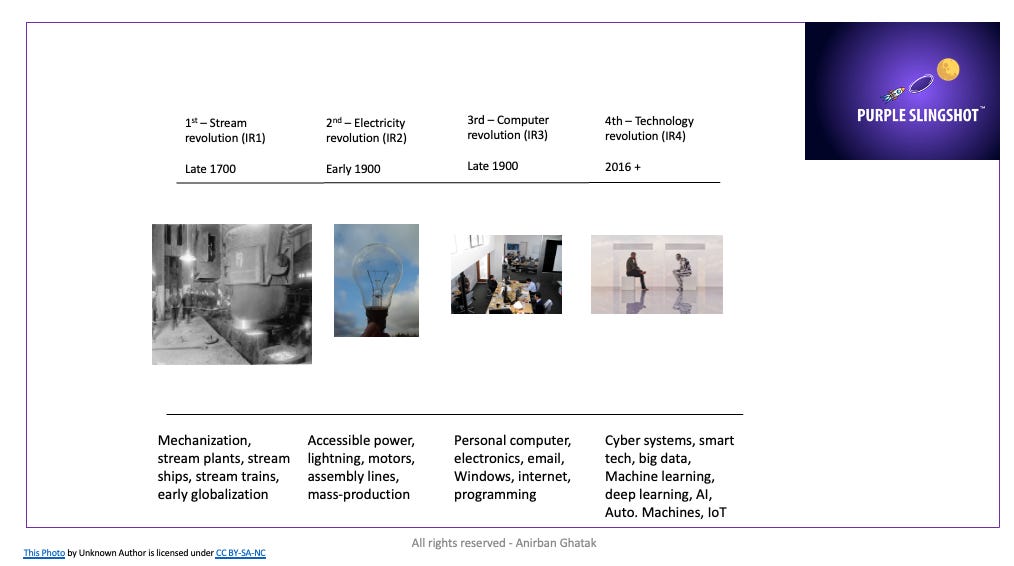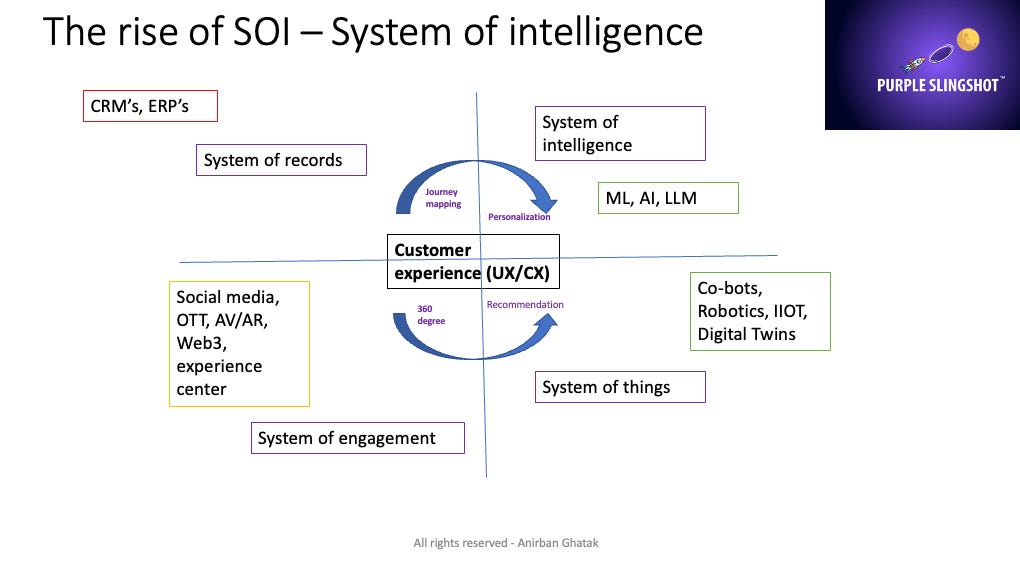The Sudden Rise of AI and ML in Today's IT roles - Welcome intelligent enterprises
Start of IR4 & System of intelligence - Impact on IT roles and demand pattern
Industry 4.0 or IR4 (industrial revolution 4.0) has impacted IT services roles and demand patterns !!
The Fourth Industrial Revolution (IR4.0) heralds a significant transformation in the way we live, work, and relate to one another. Unlike any other era, IR4.0 is characterized by a range of new technologies that fuse the physical, digital, and biological worlds, impacting all disciplines, economies, and industries.
At its core, IR4.0 is reshaping industries by integrating the digital and physical worlds through cyber-physical systems, powered by advances in communication and connectivity.
Class recording on “IR 4 vs IR3- by Anirban”:
Difference Between IR3 and IR4 | Why it matters for IT folks?
While the Third Industrial Revolution (IR3) introduced the digital era with the advent of computers and the internet, IR4.0 goes several steps further, interlinking physical, digital, and biological spheres.
Here are some key differences highlighted:
Key-notes from IR3 era - Semi-conductor, Electronics, Computer, Internet, IT, Off shore and outsourcing models.
Key-notes from IR4 era (Post 2014) - Digital experience, Digital transformation, Intelligent enterprise, Internet of everything, AI, Machine learning etc
Some other aspects to consider are:
Digitization vs. Digital transformation:
IR3: Focused on digitization, computerization, and the beginning of the internet. Projects involved mapping a business process into IT
IR4: Moves beyond mere digitization to the integration of systems, connecting machines, and intelligent data analysis. Customer experience & business strategy driven by digital is now a focus.
Connectivity:
IR3: Introduced connectivity, primarily through the internet, enabling information exchange.
IR4: Enhances connectivity to new levels with IoT, creating a network where devices communicate and make decisions.
Intelligence:
IR3: Focused on the use of software to perform specific tasks. Ex: CRM, ERP
IR4: Sees the rise of artificial intelligence (AI) and machine learning, where systems learn and adapt over time, forecasts with data and able to recomend business decisions. Ex: Recommender engine, Gen AI lead products, Intelligent routed supply chain etc
Innovation Speed:
IR3: Innovation was relatively linear and predictable.
IR4: Innovation is dynamic, disruptive, and occurring at an unprecedented rate. BANI and VUCA world at play.
How it effected IT services post 2014?
These changes impacted business models, investment drivers and how business expects to use technology in IR4.0 era. These in turn lead to a differnt skill and project pattern within IT services and rise of intelligence within intelligent enterprises.
There was also a factor of competition from incumbent as multiple customers from IR4 era now started moving towards in-spourcing or opening up Global capability centers.
“The transition from IR3 to IR4.0 is much more than a technological upgrade; it represents a fundamental shift in how technology is intertwined with every aspect of our lives, prompting both transformative potential and complex challenges.”
Class recording on “Rise of SOI - System of intelligence and customer expereince by Anirban”:
The rise of system of intelligence (Notes):
The evolution from systems of record to systems of intelligence marks a pivotal shift in the IT era, signifying a move from mere data storage to proactive, insight-driven decision-making.
This transition is reshaping businesses into intelligent enterprises. Here’s how the landscape has changed:
From Data Storage to Data Synthesis:
Systems of Record: They have been the bedrock of IT for decades, primarily focusing on data storage, management, and retrieval. These systems include databases, management information systems, and ERP systems that record transactions and business operations.
Systems of Intelligence: These systems leverage the recorded data to generate actionable insights and predictions, powered by AI and ML algorithms that learn from data patterns and behaviors.
Decision-Making Evolution:
Systems of Record: Decision-making was often reactive, based on historical data and manual analysis.
Systems of Intelligence: Now, decision-making is proactive and often automated, with predictive analytics anticipating trends and guiding strategic business moves.
Operational Efficiency:
Systems of Record: Efficiency was driven by streamlining and digitizing processes.
Systems of Intelligence: They enhance efficiency by optimizing operations in real-time, using AI to dynamically allocate resources and improve workflows.
Customer Engagement:
Systems of Record: Customer engagement was limited to managing transactions and historical customer data.
Systems of Intelligence: They personalize customer experiences by predicting needs and behaviors, enabling businesses to engage customers in a more meaningful way.
Business Model Innovation:
Systems of Record: Supported traditional business models and helped maintain the status quo.
Systems of Intelligence: They are fueling new business models, like-as-a-service offerings and outcome-based models, by enabling deeper insights and foresight.
Competitive Advantage:
Systems of Record: Provided a competitive edge through information management and process optimization.
Systems of Intelligence: They offer a distinct competitive advantage by enabling real-time strategic decisions and fostering innovation.
The rise of systems of intelligence signifies a new era where businesses are not just digital entities but are becoming 'intelligent enterprises.'
These enterprises are characterized by their ability to not only collect and store data but to interpret and act upon it intelligently and autonomously, driving growth and innovation in an ever-evolving market.
Conclusion
As we stand at the cusp of a new era shaped by systems of intelligence, businesses and professionals alike must embrace and adapt to these changes to stay competitive and relevant.
Here's an actionable conclusion for readers looking to harness the transformative power of AI and ML:
Invest in Learning:
For professionals, continuous upskilling by widening existing skills with in AI and ML is non-negotiable. Take advantage of online courses, workshops, and certifications to stay ahead.
For businesses, training employees and fostering a culture of learning will be crucial in leveraging new technologies.
Leverage Data:
Start viewing data as a strategic asset. Implement systems that not only collect and store data but also analyze and extract valuable insights from it.
Encourage business to think on data lines from IR4 era
Adopt a Data-Driven Culture:
Encourage decision-making based on data-driven insights rather than intuition. This shift will require a cultural change that promotes the use of analytics at all levels of the organization.
Innovate Business Models:
Reimagine how your business operates. Consider how systems of intelligence can create new value propositions, optimize operations, and generate new revenue streams.
Focus on Customer Experience:
Utilize predictive analytics to tailor customer experiences. Personalization is key in a market where customers expect services and products that cater specifically to their needs.
Embrace Change and Flexibility:
The future of work will be marked by agility. Both individuals and organizations must be prepared to pivot quickly in response to insights generated by intelligent systems.
By taking these steps, you can ensure that you and your organization are not just spectators but active participants in the Fourth Industrial Revolution.
The future of work will be dominated by those who can integrate intelligence into every aspect of their business, from the ground up, transforming challenges into opportunities for growth and innovation.







